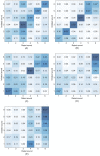Vocal imitation of percussion sounds: On the perceptual similarity between imitations and imitated sounds
- PMID: 31344080
- PMCID: PMC6657857
- DOI: 10.1371/journal.pone.0219955
Vocal imitation of percussion sounds: On the perceptual similarity between imitations and imitated sounds
Erratum in
-
Correction: Vocal imitation of percussion sounds: On the perceptual similarity between imitations and imitated sounds.PLoS One. 2019 Aug 22;14(8):e0221722. doi: 10.1371/journal.pone.0221722. eCollection 2019. PLoS One. 2019. PMID: 31437253 Free PMC article.
Abstract
Recent studies have demonstrated the effectiveness of the voice for communicating sonic ideas, and the accuracy with which it can be used to imitate acoustic instruments, synthesised sounds and environmental sounds. However, there has been little research on vocal imitation of percussion sounds, particularly concerning the perceptual similarity between imitations and the sounds being imitated. In the present study we address this by investigating how accurately musicians can vocally imitate percussion sounds, in terms of whether listeners consider the imitations 'more similar' to the imitated sounds than to other same-category sounds. In a vocal production task, 14 musicians imitated 30 drum sounds from five categories (cymbals, hats, kicks, snares, toms). Listeners were then asked to rate the similarity between the imitations and same-category drum sounds via web based listening test. We found that imitated sounds received the highest similarity ratings for 16 of the 30 sounds. The similarity between a given drum sound and its imitation was generally rated higher than for imitations of another same-category sound, however for some drum categories (snares and toms) certain sounds were consistently considered most similar to the imitations, irrespective of the sound being imitated. Finally, we apply an existing auditory image based measure for perceptual similarity between same-category drum sounds, to model the similarity ratings using linear mixed effect regression. The results indicate that this measure is a good predictor of perceptual similarity between imitations and imitated sounds, when compared to acoustic features containing only temporal or spectral features.
Conflict of interest statement
The authors have declared that no competing interests exist.
Figures





Similar articles
-
Vocal Imitations of Non-Vocal Sounds.PLoS One. 2016 Dec 16;11(12):e0168167. doi: 10.1371/journal.pone.0168167. eCollection 2016. PLoS One. 2016. PMID: 27992480 Free PMC article.
-
Exploring sound perception through vocal imitations.J Acoust Soc Am. 2020 May;147(5):3306. doi: 10.1121/10.0001224. J Acoust Soc Am. 2020. PMID: 32486800
-
Vocal imitation of synthesised sounds varying in pitch, loudness and spectral centroid.J Acoust Soc Am. 2017 Feb;141(2):783. doi: 10.1121/1.4974825. J Acoust Soc Am. 2017. PMID: 28253682
-
Vocal imitations of basic auditory features.J Acoust Soc Am. 2016 Jan;139(1):290-300. doi: 10.1121/1.4939738. J Acoust Soc Am. 2016. PMID: 26827025
-
Auditory signal processing in communication: perception and performance of vocal sounds.Hear Res. 2013 Nov;305:144-55. doi: 10.1016/j.heares.2013.06.007. Epub 2013 Jul 1. Hear Res. 2013. PMID: 23827717 Free PMC article. Review.
Cited by
-
Correction: Vocal imitation of percussion sounds: On the perceptual similarity between imitations and imitated sounds.PLoS One. 2019 Aug 22;14(8):e0221722. doi: 10.1371/journal.pone.0221722. eCollection 2019. PLoS One. 2019. PMID: 31437253 Free PMC article.
-
Searching for perceptual similarity within, and between, the (chemical) senses.Iperception. 2022 Sep 22;13(5):20416695221124154. doi: 10.1177/20416695221124154. eCollection 2022 Sep-Oct. Iperception. 2022. PMID: 36176976 Free PMC article.
References
-
- Andersen K, Grote F. GiantSteps: Semi-structured conversations with musicians. In: Proceedings of the 33rd Annual ACM Conference Extended Abstracts on Human Factors in Computing Systems. Seoul, Korea; 2015. p. 2295–2300.
-
- Sundberg J. The Science of the Singing Voice. Illinois, USA: Northern Illinois University Press; 1989.
-
- Atherton M. Rhythm-Speak: Mnemonic, Language play or Song? In: Proceedings of the International Conference on Music Communication Science. Sydney, Australia; 2007. p. 15–18.
-
- Lemaitre G, Dessein A, Susini P, Aura K. Vocal imitations and the identification of sound events. Ecological Psychology. 2011;23(4):267–307. 10.1080/10407413.2011.617225 - DOI
Publication types
MeSH terms
LinkOut - more resources
Full Text Sources

